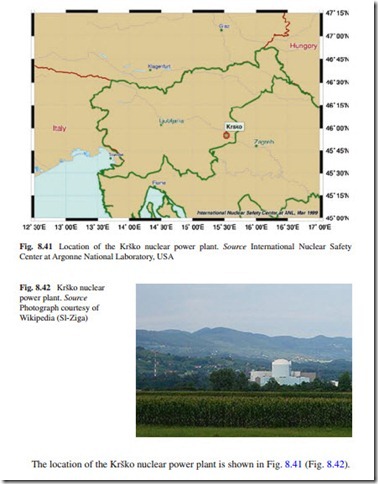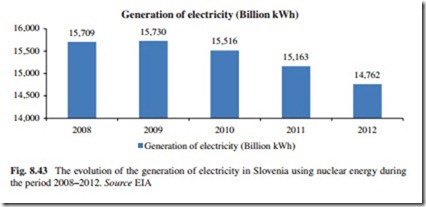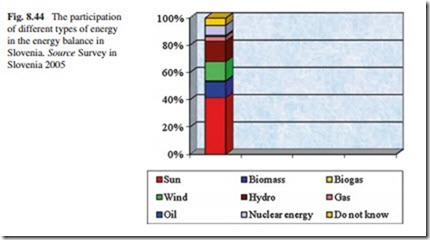Slovenia
The government of Slovenia laid down its energy policy objectives and main priorities for the development of the energy system in its Resolution on the National Energy Plan (NEP) adopted in 2004. The NEP foresees the use of nuclear energy as a contributor to the transition to reliable low-carbon power supply sources. The measures for achieving the objectives included in the NEP are structured in four sub-programs:
• Sustainable use and local energy supply, with the following sub-programs: (a) Efficient use of energy; (b) Use of energy in transport; (c) Renewable energy sources; and (d) Local energy supply and cogeneration of heat and electricity;
• Electricity supply, with the following three sub-programs: (a) Electricity generation; (b) Electricity transmission; and (c) Electricity distribution network;
• Fuel supply, with the following four sub-programs: (a) Natural-gas supply; (b) Liquid fuels; (c) Coal; and (d) Nuclear energy;
• Horizontal sub-programs. With the following five sub-programs: (a) Development of electricity and natural gas market; (b) Taxes and regulated prices; (c) Education and training; (d) Research and development; and (e) Spatial planning.
Further measures in the NEP include:
• Maintaining diversity of sources, technologies, and locations in electricity generation at least at the present level;
• Provision of a majority share of production from domestic energy resources;
• Further long-term exploitation of nuclear energy in Slovenia by increasing the period of operation of Krško nuclear power plant and construction of a new nuclear power reactor in Krško (NPPK 2), bearing in mind social acceptability and directed use of fossil fuels with the long-term objective of transition to a low-carbon society. The deep considers nuclear as one of the sources in a diverse electrical supply.
The NEP states: “The most important objectives in nuclear energy are further safe operation of nuclear facilities in Slovenia and maintaining the independence of the supervision authority (the Slovenian Nuclear Safety Administration). The extension of the operational life of Krško nuclear power plant until at least 2043 is of key importance for long-term competitive electricity supply. The construction of a new nuclear power plant of 1,100–1,700 MW is possible in Krško. The project is positive from the perspective of energy; what is required is an appropriate distribution of the increased costs of system services among producers and consumers of energy. With a life expectancy of 60 years, the project may be extremely competitive; it will, however, pose a great challenge to investors in the period of construction and repayment of loans of the second block. Due to the size of this project, electricity generation will largely depend on the regional electricity market, especially in the initial period of operation. The actual realization of the new nuclear power plant will depend on conditions in the market, business decisions, and social acceptability of the project. In terms of personnel capacities, organization of implementation and financial sources, the implementation of the investment is the most demanding projects of the NEP requiring mobilization of a large part of Slovenian development potential.”
Slovenia has rather limited energy reserves and, for this reason, should import almost all its oil and gas to be used for the electricity generation and heating, essentially from Algeria and Russia. Lignite is its main source of energy of the country.
Slovenia has one nuclear power plant in operation located in Krško near the Croatian border, with a net power capacity of 688 MWe. The reactor is of the PWR type. The Krško nuclear power plant produced, in 2013, a total of 5,036.47 GWh, which represents 33.56 % of the total electricity produced by the country in that year (see Table 8.29).
The Energy Policy in Slovenia
The government of Slovenia adopted, in January 1996, a resolution describing its energy policy objectives and main priorities for the development of its energy system in the country for the coming years. The resolution adopted was entitled “Resolution on the Strategy of Energy Use and Supply of Slovenia.” Three years later, in September 1999, the government adopted a new energy law to provide the legal framework for the development of the nuclear energy sector in the country. In 2003, the Slovenian government endorsed the NEP. The time horizon of NEP is 2000–2020. The adopted economic scenario foresees that Slovenia’s will grow 4 % annually. After 2009, it will stabilize around 2.2 % per annum until 2020. According to the economic scenario described in NEP, as the main driving force for energy demand, total primary energy demand will grow in the period 2000– 2020 by 1.1 % annually. Electricity is foreseen to grow 1.5 % annually.
NEP sets the guidelines for the energy policy of the country taking into account the three main objectives of the energy sector:
• Security of energy supply;
• Competitive energy prices;
• Sustainable development and mitigation of environmental impacts of energy generation and consumption.
The main goals of the Slovenian Energy Policy could be summarized in the following activities:
• To maintain the present availability of energy sources;
• To further improvements of technical reliability of energy networks and quality of supply;
• To implement measures for the efficient use of energy;
• To match electricity at the level of final consumption by international standards;
• To promote the opening of electricity and natural gas market;
• To promote the efficient use of energy;
• To increase the share of renewable sources of energy in the primary energy demand;
• To maintain the long-term exploitation of lignite;
• To keep the nuclear option for electricity generation;
• To enable the 90 days reserves of liquid fuels.
For the period 2020–2030, the energy goals can be summarized as follows:
• Double cogeneration capacity by 2020;
• Increase energy efficiency of 20 % by 2020 and 27 % by 2030;
• Renewables share in brutto final energy use of 25 % by 2020 and 30 % by 2030;
• Reduction of greenhouse gas emissions of 9.5 % by 2020 and 18 % by 2030;
• Reduction of energy intensity by 29 % by 2020 and 46 % by 2030;
• Have 100 % energy neutral buildings among new built and renovated in public sector by 2018 and elsewhere by 2020;
• Limit energy dependence on imports to less than 45 % by 2030;
• More international and regional interconnections.
Nuclear electricity production 5,036.47 GWh
Electricity Generation Using Nuclear Energy
The production of electricity in Slovenia in 2013 and the generation of electricity using nuclear energy are shown in Table 8.30.
To satisfy the foreseeable increase in the electricity demand of the country dur- ing the coming years, the Slovenian government is considering the construction of one additional nuclear power reactor with a net capacity of 1,000 MWe in 2017.
The evolution of the generation of electricity in Slovenia using nuclear energy during the period 2008–2012 is included in Fig. 8.43.
According to Fig. 8.43, the generation of electricity in Slovenia using nuclear energy during the period 2008–2012 dropped 6.1 %. It is expected, however, that the generation of electricity using nuclear energy increases in the future, if the decision of the government to construct another nuclear power reactor in 2017 starts to be implemented.
The Public Opinion
According to Morales Pedraza (2012), a survey on the production of clean elec- tricity in Slovenia was carried out by the agency Ninamedia between 14 and April 15, 2005. Around 300 persons were inquired. The results of the survey can be summarized as follows: If people had the possibility to choice electrical energy from different energy sources, the most of the examinees (86 %) would decide for
natural sources, 5.5 % would choose fossil energy sources, and only 4 % nuclear energy. Around 60.3 % of examinees are prepared to pay a higher price for electrical energy from renewable energy sources. A quarter of them are willing to pay a price, which is higher just for 2 %; a total of 37 % are willing to pay till 5 % higher price, and 23.3 % till 10 %.
Most of examinees considering that the strongest trend of growth in Slovenia in the field of green electricity production in the next five years will be hydropower (28 %), followed by solar energy (22 %), wind energy (19.7 %), biomass energy (13 %), biogas energy (4.7 %), and geothermal energy (2.7 %). The electrical energy sources of the future are, for most of the examinees, solar (41.7 %), hydro (15 %), wind (14 %), and biomass (10 %). Nuclear power is the energy source for the future for only 7.3 % of examinees (Survey in Slovenia 2005) (see Fig. 8.44).
Despite of the fact that there is no active and strong opposition to the use of nuclear energy for electricity generation in the country, only a small part of the pop- ulation, according to this survey, is thinking in the use of this type of energy for the production of electricity in the future. More than 70 % support the use of alternative energy source for the generation of electricity in Slovenia during the coming years.
Looking Forward
In Slovenia, a second nuclear power reactor is under the consideration by the Slovenian authorities. However, before a decision is taken regarding the construction of a second nuclear power reactor in the country, three issues should be clearly solved. These are the following:
• Social acceptance of the use of nuclear energy for electricity generation;
• Safe functioning of the nuclear power plant;
• Safe disposal of medium and low level radioactive waste.
Regarding the technical requirements of the new nuclear power reactor that could be built in the country in the future, these are the following:
• Light water pressurized reactor (PWR-generation III) with enhanced technology, improved safety, and economic competitiveness;
• Possible use of MOX fuel (recycled fuel);
• Lifetime of 60 years;
• Base load or load follows operation;
• Less radioactive waste;
• Very strong preference to the nuclear power plants, which are or will be in operation/construction or at least that they have design certification/license in Europe;
• Fulfillment of the highest international safety requirements and standards.
At the same time, and taking into account the unresolved dispute about the ownership of the Krsko nuclear power plant, the Croatian parliamentary parties give consent to ratify a Croatian-Slovene agreement for the dismantlement of the Krško nuclear power plant in the future. The plant, scheduled to operate until 2023, would undergo dismantlement procedures from 2017 until 2042. In March 2005, a joint Slovene-Croatian commission agrees to the establishment of a program for the dismantlement of the Krško nuclear power plant, and the storage of low and medium radioactive waste. The Slovenian government has appropriated €115 mil- lion for the implementation of the program.




